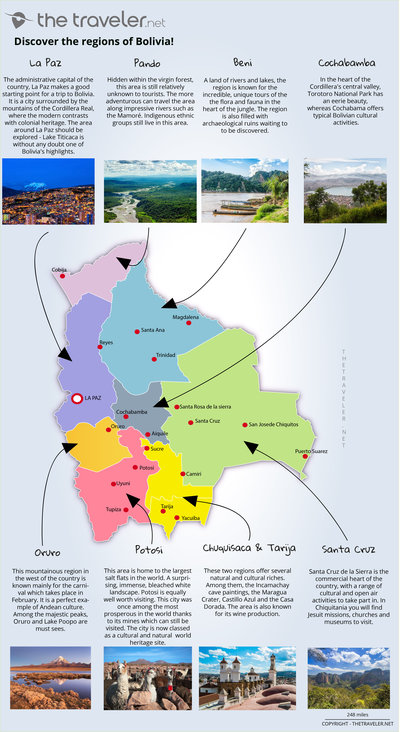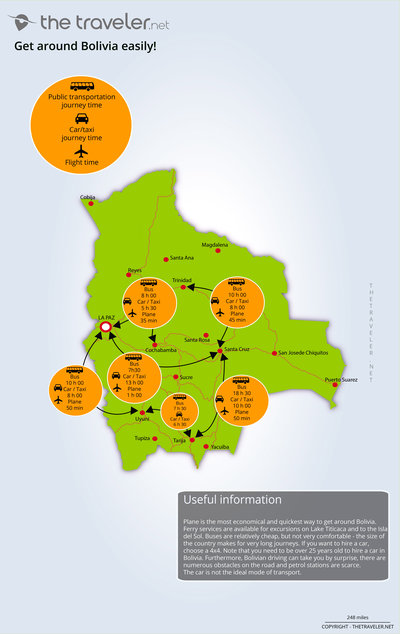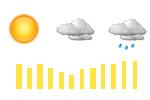Plan an amazing trip to Bolivia
Discover a surprising country of breathtaking countryside and cultural riches. La Paz, built at over 3,000 metres altitude is a city surrounded by high mountains - Huayna Potosí and Nevado Illimani. Photographers will be bowled over by the salt flats of Salar de Uyuni. For the sporting, there is hiking in the Andes and windsurfing on the famous Lake Titicaca. And for adventurers,, the Amazonian jungle to the north of the country is still pristine. One thing is certain, a trip to Bolivia will never leave you.
Best time to go to Bolivia
The Bolivian climate varies according to region and altitude. The country can be divided in three. La Paz and the east, above 3,000 metres altitude has a dry season from April to November and an austral winter. In the centre of the country, the valleys have a milder climate. July and August are marked by heavy rain and high temperatures. Meanwhile, the north of the country experiences high temperatures interspersed with by cold blasts of the surazo, the icy Patagonian wind.
How to go Bolivia ?
What are the arrival airports?
Choose the closest airport to where you are staying.From which airport should I leave?
Check the flight calendar for departures from Bolivia cities served by direct flights.What to see and what to do in Bolivia
Answers to your most frequently asked questions
No, a visa is not necessary for travel to Bolivia for stays of less than 90 days. As long as your passport has 6 months validity from the date of your return, it will suffice. For information about travelling to Bolivia, visit "https://www.gov.uk/foreign-travel-advice/bolivia" before you leave.
Theft is a risk in Bolivia. In order not tempt fate, follow a few basic rules. Don't display valuable objects or jewellery in public and keep cash somewhere pickpockets will have difficulty finding. Don't get into just any taxi, as some are frauds which aim fleece tourists. Some thieves even pose as the police. Make photocopies or scans of your important documents such as your passport and plane tickets in case of theft or loss.
There are no compulsory vaccinations although course or boosters for hepetitis A and tetanus are recommended. Depending on where you travel, some vaccinations are advised (hepititus A and B, typhoid Fever) especially in the Amazon or in rural areas. Speak to your doctor who is the best person to advise you.
Only drink bottled water, tap water should be avoided. Remember to wash your hands regularly. Avoid raw fruit and vegetables (salads, fruit juice) unless you can peel them and freeze them. Animals roam the streets - don't stroke them as they could be carrying rabies.
In Bolivia you are likely to be hiking at significant altitudes of 5,000 to 6,000 metres. Being in good physical condition is recommended. Visit your doctor for a checkup where you can explain the kind of trip you have in mind. Altitude can provoque Acute Mountain Sickness (AMS) which is characterised by headaches and difficulty breathing. Your doctor can prescribe medicine to relieve the symptoms. Don't buy medicine in the street and remember to take a simple first aid kit. Take a few days from your arrival to acclimatise and start your hiking gradually, remembering to drink water regularly. A visit to the dentist is also recommended as altitude can trigger toothache.
During your trip to Bolivia, stroll through a market to discover the different flavours of the local cuisine. Soup is often served and can be a meal in itself. Sopa de mani has potatoes, meat, thick cream, peanuts and spices. Sopa de quinoa and sopa le chairo are made with meat and vegetables. Main courses are generally meat based, such as chicarrones - pieces of chicken or pork cooked in oil, or pique macho, a very spicy dish with cubes of grilled beef, chips, tomatoes and hot red peppers. Desserts are varied and feature tropical fruit, ice cream, chocolate (especially in Sucre) and almond paste. As for drinks, you will be pleasantly surprised by the region's wine as well as the reputable local beers.There is also chica, a drink made from corn and cereals and mate de coca which is a herbal tea said to have many properties, made from coca leaves.
There are 38 spoken languages in Bolivia. The main language is Spanish. The remaining 37 are indigenous languages which are taught in schools. English is rarely spoken and you will do better if you have a grasp of Spanish.
Bolivia is not necessarily a suitable destination for children. First there is the altitude, which can make children as well as adults poorly. Then there are the lengthy journey times from one place to another. The climate can also be severe at high altitudes and long walks can be tiring. There are other better destinations for your little ones.
The road conditions in Bolivia are not very good and driving can be dangerous. We recommend hiring a car and driver - you will be more at ease and better able to enjoy the scenery. Driving is quicker than bus or train. Take a look at our travel map to find out how long journeys will take in Bolivia
Keep some space in your bags as you will want to bring back beautiful alpaca wool scarves, jumpers, caps and ponchos. Aguayos are beautiful woollen cloths which make lovely souvenirs.There are also sculpted wooden objects and silver jewellery.
Plugs are identical to European 2 pin plugs, so you will need an adapter.
Most hotels have wi-fi, but be patient as connection speeds can be slow.





























